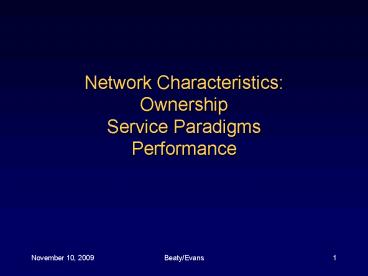Network Characteristics: Ownership Service Paradigms Performance PowerPoint PPT Presentation
1 / 24
Title: Network Characteristics: Ownership Service Paradigms Performance
1
Network CharacteristicsOwnershipService
ParadigmsPerformance
2
Network Ownership
- Private network owned and used by single entity
- Most LANs
- Many corporations have their own WANs
- Use leased lines, transmissions do not occur over
common carriers
3
Network Ownership Continued
- Public network owned by common carrier and used
by many - Universal service any subscriber can communicate
to any other - Public in the sense that transmissions from all
go through same hardware - Transmissions not broadcast
4
Private Pros/Cons
- Complete hardware control
- Capacity, etc.
- Policy control
- Isolation/security
- Expense
- Equipment, personnel
- Have to track technology
5
Public Pros/Cons
- Much less expensive
- Rely on common carrier to keep up to date
- Data not private
- Less secure
- Less direct control!
6
VPNs
- Virtual Private Network (VPN) provides service
where a public network appears to be private - Entity has multiple sites
- Use special hardware/software to encrypt all
transmissions between sites
7
VPNs Continued
- Can disallow all other traffic or encrypt only
traffic to certain sites - Now if anyone sees transmissions they cant
decode them
8
Transmission Paradigms
- Two major forms connection-oriented (CO) and
connectionless (CL) - CO like a phone call
- Connection must be initialized
- Connection used in accordance to agreed upon
parameters for transmission - Connection released
9
Connection Oriented
- Can be engineered for fixed or variable data
rates - Connection is not dropped if no data transferred
- Connection can either be simplex (two connections
required) or full duplex - Can be either permanent or switched
10
CO Continued
- Can guarantee a performance level and have
other QoS aspects easier measurement and data
capture - Might have either stream or message interface
- Stream no boundaries on transmissions
- Message destination receives exactly same size
blocks as sent
11
Connection Less
- Like the post office
- Each message addressed
- No setup or tear down
- Typically no service guarantee
- Good for short transmissions
- CO typically has abbreviated destination address
12
Comments
- CO has immediate feedback for network failure
- Note CO vs. CL can occur at many different
levels of network hierarchy
13
Examples
14
Performance Characteristics
- A number of ways to measure effectiveness of
network - Might want different metrics for different levels
or types of connections
15
Delay
- How long does one bit take to transit network?
- Measured in fractions of a second
- May be expressed in maximum and average delay
16
Types of Delay
- Propagation proportional to distance traveled
- Speed of light
- Switching electronics in hubs, bridges, etc.
time to do the basic message switching job - Access time it takes to gain medium
- CSMA/CD
- Queuing time spent in router queue time cost
due to other messages
17
Throughput A Capacity Measure
- Rate at which data transferred
- Really how many bits can enter network per unit
of time how much can the network hold? - Measured in bits per second
- Not exactly equal to bandwidth
- Bandwidth theoretical hardware limit
- Throughput will be less due to headers and other
losses of bandwidth - Not speed as it measures rate not delay
18
The Need for Speed
- Think of I-25 from Denver to Fort Collins as the
network with one big lane - Takes one car 60 minutes to reach Fort Collins -
This is speed or delay - Two cars can enter I-25 a minute,
- Capacity, bandwidth 2 cars per minute
- One lane 120 cph
- If we add bandwidth (another lane) we could get
up to 4 cars per minute
19
Congestion
- Utilization (U) of given throughput
- Proportion between 0 and 1 of total capacity in
use - 0 means none used (idle). 1 means fully used.
- Too many packets on link at a time
- Increases delay
- Delay can be estimated from percentage of
congestion - DD0/(1-U)
- D0idle delay
- Upercentage utilized
20
Utilization For 250 ms Delay (D0)
21
Congestion Continued
- One chooses acceptable utilization before
upgrading - 50 -- 80 typical
22
Delay-Throughput Product
- Another figure of merit is delay times throughput
- Might be a better measurement than either alone
- Measure of how much data on link at a time
- I-25 model (as above)
- Product
- (2 cars per minute) ? (60 minutes) 120 cars
- What adding bandwidth will do
23
Jitter
- Variance in delay
- Regularity of delivery
- If always at same time ? zero jitter
- Low jitter important for audio and video
- Isochronous networks have a jitter of zero
- Asynchronous networks more and more carrying
voice and video and using algorithms to mitigate
jitter
24
Exercises
- Problems 15.3, 15.4, 15.6, 15.7

